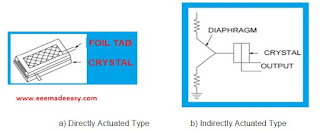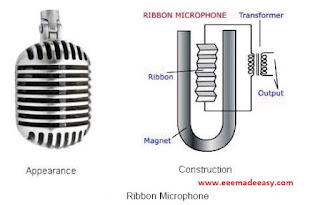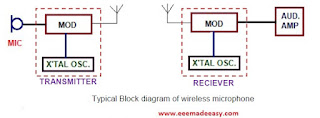What is a Microphone? |Types of Microphones
What is a Microphone?
MICROPHONES
The microphone is a transducer that converts acoustic energy into electrical energy.
Microphones may be classified:
According to Mode of operation:
i) Pressure operated
ii) Velocity operated
Pressure operated microphones
Pressure-operated microphones employ a diaphragm with only one surface exposed to the sound source.
The displacement of the diaphragm is proportional to the instantaneous pressure of the sound wave.
At lower frequencies, such microphones generally cause a resonant response, giving rise to a peak that may reach 6 to 8 dB with reference to 1000 Hz.
The pressure-operated microphones are carbon, crystal, dynamic and capacitor microphones.
Velocity operated microphones
A velocity microphone is one in which the electrical output substantially corresponds to the instantaneous particle velocity in the addressed sound wave.
A velocity microphone is also referred to as a gradient microphone. A gradient microphone is a microphone in which the output corresponds to the gradient of the sound pressure.
The velocity-operated microphones are ribbon microphones.
Types of microphones
Carbon Microphone
In a carbon microphone, small carbon granules are held in close contact in a brass cup called a "button" which is attached to the centre of a metallic diaphragm.
Sound waves, striking the surface of the diaphragm, disturb the carbon granules changing the contact resistance between their surfaces.
The change in contact resistance causes a current from a battery connected in series with the carbon button and the primary of a transformer to vary in amplitude, resulting in a current waveform similar to the acoustic waveform striking the diaphragm.
After leaving the secondary of the transformer, the minute changes of current through the transformer
primary are amplified and reproduced in a conventional manner.
The circuit diagram as well as the construction of a single button carbon microphone is shown in Fig. below.
The output voltage from a carbon or pressure microphone is proportional to the displacement of the diaphragm.
The field pattern is circular.
One of the disadvantages of the carbon microphone is that it has continuous high-frequency
hiss caused by the changing contact resistance between the carbon granules. In addition, the
frequency response is limited and the distortion is rather high.
Carbon microphones used in
communications i.e., telephone networks are designed to be
moved, with the current flowing
through them.
2. Crystal Microphone:
A crystal microphone employs one
or more Rochelle salt crystals placed in such a manner that
when their surfaces are struck by
a pressure wave, they are bent or twisted out of shape. This
action results in the generation
of an electrical current because of the piezoelectric effect of
such crystals.
When a crystal is subjected to
strain, electrical polarization takes place. The polarization is
proportional to the mechanical
strain. The inverse effect is produced when electrical current is
applied to the crystal. The
mechanical movement in this case is proportional to the applied
current.
3. Dynamic Microphone:
The dynamic or moving coil
microphone employs a voice coil attached to a diaphragm. The
sound pressure on the diaphragm
makes to move the coil in a strong magnetic field, which
generates a voltage proportional
to the sound pressure at the diaphragm. This microphone is
also referred to as a pressure
microphone.
Microphones of this type do not
require output transformers. The output voltage is taken directly
from the voice coil. The output
impedance is approximately 200 Ohms. A low impedance of this
nature permits the microphone to
be placed at a considerable distance from the preamplifier
without affecting the microphone
characteristics. This microphone, like other pressure-operated
microphones has a circular field
pattern. This is the most widely used microphone in these days.
4. Condenser Microphone
This is based on the principle of
variable capacitance. It is polarised by a battery. The
appearance and basic functioning is shown in fig.
. The diaphragm of this microphone is a thin membrane of nickel, which is spaced about 0.001 inches (25 meters) from the fixed back
plate keeping air as the
insulating medium. As long as the diaphragm is not exposed to the
sound pressure, the capacitance
remains constant and the AC output voltage will be zero.
Whenever the sound waves strike
the diaphragm, it undergoes compressions and ratification
and the capacitance across the
microphone varies. The capacitance is inversely proportional to
the distance or space between the
two plates. Q = CV. Since the voltage remains constant the
variations in capacitance varies
the charge. The current in the circuit varies making a variable
voltage drop across resistance
'R'. AC output voltage is taken through a capacitor and
immediately fed to a
pre-amplifier.
The function of a polarising
voltage or its equivalent is to translate the diaphragm’s motion into a
linearly related audio output
voltage, which is amplified by a very high impedance FET which
must be located close to the
capacitor. Special measures must be taken to prevent the space or
distance between the capacitor
plates from changing because of temperature and humidity.
Use of foam windscreens for
protection in damp or corrosive environments is recommended.
Frequency response is fair over
the entire audio spectrum. It requires a polarising battery and a
preamplifier. It is basically an
omni directional microphone; it is best for indoor and outdoor use
5. Ribbon Microphone:
The ribbon (velocity) microphone
is a microphone in which a very light metallic ribbon is
suspended in a strong magnetic
field. Pressure waves cause the ribbon to vibrate in the
magnetic field generating voltage
corresponding to the particle velocity of the pressure wave.
Velocity microphones may be
designed to have a wide frequency range, good sensitivity, low
distortion, and low internal
noise
6. Wireless or cordless microphone:
Wireless microphones are
classified as of two types. These are handheld and collar type. The
specific application of handheld
mic is that, a person giving a performance in between a
programme can hold this mic in
his hand and give the announcements as and when desired.
Whereas the collar type mic can
be used by a person gives any demonstration or lecture by
permanently fixing the mic to his
collar of his shirt, so that he can freely move. A typical example
of a wireless microphone system
consists of a lapel microphone concealed in the clothing of the
user
Wireless mic works on the
principle of VHF radio transceiver system. It consists of two units.
The microphone along with
transmitter is one unit and receiver the other. The microphone
output is fed to the input of the
transmitter’s modulator circuit as an AF signal. A crystal
oscillator will generate the
necessary carrier frequency and fed to modulator. The AF generated
by the mic is modulated with the
carrier signal and transmitted as RF signal. The transmitter
circuit requires an operating dc
voltage of 9V, which will be provided by dry cell inside the
casing of the microphone unit.
The receiver consists of a
collapsible antenna and a demodulator circuit with a crystal oscillator.
The transmitted signal is
received by a receiver located at a remote point (near the audio
amplifier) and converts back to
audio signal. This AF signal is connected to the input of an audio
amplifier through jacks. The
receiver circuit requires operating voltage of 12V dc.
The maximum transmitting distance
under normal conditions is about 200 feet. When several
wireless microphones are used on
the same set, each microphone transmitter must be operated
on a different frequency to avoid
interference.












0 Comments